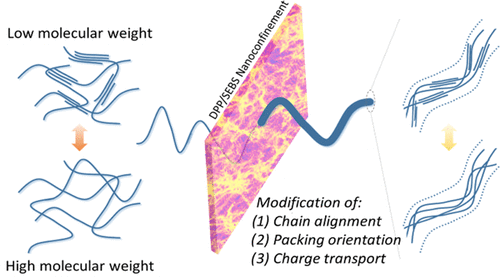当前位置:
X-MOL 学术
›
Chem. Mater.
›
论文详情
Our official English website, www.x-mol.net, welcomes your
feedback! (Note: you will need to create a separate account there.)
Inducing Molecular Aggregation of Polymer Semiconductors in a Secondary Insulating Polymer Matrix to Enhance Charge Transport
Chemistry of Materials ( IF 7.2 ) Pub Date : 2020-01-14 , DOI: 10.1021/acs.chemmater.9b05228 Shayla Nikzad, Hung-Chin Wu, Jenny Kim, Christine M. Mahoney, James R. Matthews, Weijun Niu, Yang Li, Hongxiang Wang, Wen-Chang Chen, Michael F. Toney, Mingqian He, Zhenan Bao
Chemistry of Materials ( IF 7.2 ) Pub Date : 2020-01-14 , DOI: 10.1021/acs.chemmater.9b05228 Shayla Nikzad, Hung-Chin Wu, Jenny Kim, Christine M. Mahoney, James R. Matthews, Weijun Niu, Yang Li, Hongxiang Wang, Wen-Chang Chen, Michael F. Toney, Mingqian He, Zhenan Bao

|
Polymer semiconductors (PSCs) are a desirable class of materials for next-generation electronics. However, the conformational complexity associated with macromolecules, as well as the presence of unique inter- and intrachain interactions, make it challenging to control the morphology of PSCs. Previously, it has been reported that beyond a certain molecular weight, thin-film charge carrier mobility typically drops due to reduced crystallinity and increased entanglement. Here, the use of an insulating secondary matrix polymer, polystyrene-block-poly(ethylene-ran-butylene)-block-polystyrene (SEBS), is shown to induce molecular ordering of PSCs across multiple length scales. Aggregation-induced molecular ordering in SEBS/PSC hybrid films is strongly correlated to the molecular weight of the semiconducting component. The higher the molecular weight of PSC used to blend with SEBS, the greater the observed improvement in polymer aggregation and orientation. This leads to a 5-fold increase of charge carrier mobility, from 0.3 to 1.5 cm2 V–1 s–1 (P-97k), in field-effect transistors (FETs) with only 30 wt % of the semiconducting polymer in SEBS. Moreover, mobility can be further elevated to 2 cm2 V–1 s–1 using an extensional flow-driven solution shearing deposition method. The findings here on using a secondary polymer matrix to dramatically improve the molecular organization and charge transport of a high-molecular-weight PSC are a useful morphological control strategy. It can also be carried out using nonhalogenated solvents, such as p-xylene, which are more environmentally benign and industrially relevant than commonly used chlorinated solvents.
中文翻译:

在次级绝缘聚合物基体中诱导聚合物半导体的分子聚集以增强电荷传输
聚合物半导体(PSC)是下一代电子产品的理想材料类别。然而,与大分子相关的构象复杂性,以及独特的链间和链内相互作用的存在,使得控制PSC的形态具有挑战性。以前,据报道,超过一定分子量,由于降低的结晶度和增加的缠结,薄膜载流子迁移率通常下降。在这里,显示出使用绝缘的次级基体聚合物,聚苯乙烯-嵌段-聚(乙烯-亚丁基)-嵌段-聚苯乙烯(SEBS),可以在多个长度尺度上诱导PSC的分子排列。SEBS / PSC杂化膜中聚集诱导的分子有序与半导体组分的分子量密切相关。用于与SEBS共混的PSC的分子量越高,观察到的聚合物聚集和取向的改善就越大。这导致电荷载流子迁移率从0.3厘米增加到1.5厘米,增加了5倍在场效应晶体管(FET)中为2 V –1 s –1(P-97k),SEBS中的半导体聚合物仅占30 wt%。此外,使用扩展的流驱动溶液剪切沉积方法,可将迁移率进一步提高到2 cm 2 V –1 s –1。此处使用二级聚合物基质显着改善高分子量PSC的分子组织和电荷传输的发现是一种有用的形态控制策略。它也可以使用非卤代溶剂(如对二甲苯)进行,与传统的氯化溶剂相比,这种溶剂对环境无害且在工业上更为重要。
更新日期:2020-01-15
中文翻译:

在次级绝缘聚合物基体中诱导聚合物半导体的分子聚集以增强电荷传输
聚合物半导体(PSC)是下一代电子产品的理想材料类别。然而,与大分子相关的构象复杂性,以及独特的链间和链内相互作用的存在,使得控制PSC的形态具有挑战性。以前,据报道,超过一定分子量,由于降低的结晶度和增加的缠结,薄膜载流子迁移率通常下降。在这里,显示出使用绝缘的次级基体聚合物,聚苯乙烯-嵌段-聚(乙烯-亚丁基)-嵌段-聚苯乙烯(SEBS),可以在多个长度尺度上诱导PSC的分子排列。SEBS / PSC杂化膜中聚集诱导的分子有序与半导体组分的分子量密切相关。用于与SEBS共混的PSC的分子量越高,观察到的聚合物聚集和取向的改善就越大。这导致电荷载流子迁移率从0.3厘米增加到1.5厘米,增加了5倍在场效应晶体管(FET)中为2 V –1 s –1(P-97k),SEBS中的半导体聚合物仅占30 wt%。此外,使用扩展的流驱动溶液剪切沉积方法,可将迁移率进一步提高到2 cm 2 V –1 s –1。此处使用二级聚合物基质显着改善高分子量PSC的分子组织和电荷传输的发现是一种有用的形态控制策略。它也可以使用非卤代溶剂(如对二甲苯)进行,与传统的氯化溶剂相比,这种溶剂对环境无害且在工业上更为重要。











































 京公网安备 11010802027423号
京公网安备 11010802027423号